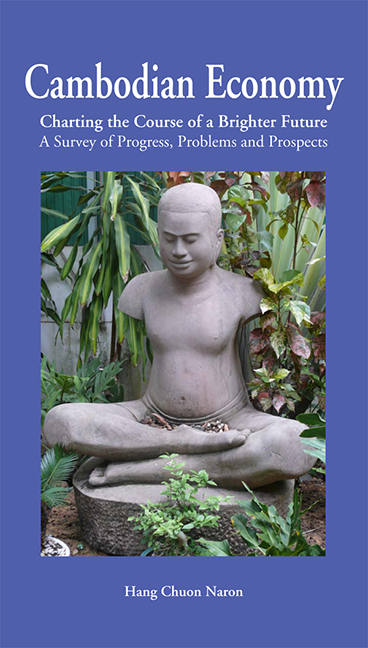 Cambodian Economy
Cambodian Economy Book contents
- Frontmatter
- Contents
- Foreword
- Preface
- INTRODUCTION
- Symbols and abbreviations
- PART I GEOGRAPHY AND POPULATION
- PART II MACROECONOMIC FRAMEWORK
- PART III THE CHALLENGE OF MODERNIZING AGRICULTURE
- PART IV THE CHALLENGE OF INDUSTRIALIZATION
- PART V SERVICES AND INFRASTRUCTURE
- PART VI HUMAN RESOURCE DEVELOPMENT
- PART VII PUBLIC FINANCE
- PART VIII INTERNATIONAL ECONOMIC RELATIONS
- PART IX CONCLUSION
- Chapter 25 Accelerating Institutional Development — The Key to Progress
- Bibliography
- About the author
Chapter 25 - Accelerating Institutional Development — The Key to Progress
from PART IX - CONCLUSION
Published online by Cambridge University Press: 21 October 2015
- Frontmatter
- Contents
- Foreword
- Preface
- INTRODUCTION
- Symbols and abbreviations
- PART I GEOGRAPHY AND POPULATION
- PART II MACROECONOMIC FRAMEWORK
- PART III THE CHALLENGE OF MODERNIZING AGRICULTURE
- PART IV THE CHALLENGE OF INDUSTRIALIZATION
- PART V SERVICES AND INFRASTRUCTURE
- PART VI HUMAN RESOURCE DEVELOPMENT
- PART VII PUBLIC FINANCE
- PART VIII INTERNATIONAL ECONOMIC RELATIONS
- PART IX CONCLUSION
- Chapter 25 Accelerating Institutional Development — The Key to Progress
- Bibliography
- About the author
Summary
General Development Framework
During its second mandate, from 1998 to 2003, the RGC implemented the Triangular Strategy to focus on achieving peace and stability, normalizing relations with the rest of the world and marshalling resources to accelerate economic development and fight poverty. The strategy was successful in creating an environment conducive to progress, leading Cambodia on the path of reforms and sustainable development. Cambodia transformed from a backward country facing an uncertain future, and ravaged by war, conflicts, and instability, into a zone of lasting peace, security, and public order.
However poverty and inequity in income distribution have emerged as the greatest challenges facing the nation. In order to quickly solve the poverty problem and reach the Millennium Development Goals (MDGs), the RGC launched, in March 2003 the National Strategy for Poverty Reduction, with the following objectives:
• Strengthening peace, stability, and public order through the implementation of concrete measures aiming to improve the rule of law, promote respect for human rights and democracy, and create a political and security framework conducive to continued development.
• Ensure a strong rate of sustainable economic growth, 6-7% per year on average.
• Ensure an equitable distribution of spin-offs from the economic growth between rich and poor, urban and rural communities, men and women, and
• Promote sustainable management of the environment and natural resources.
The RGC's agenda is not limited to fighting poverty. Its vision for development is one of social cohesion, with a state-of-the-art educational system and abundant cultural wealth. Making the vision into reality will require unfailing respect for the values of social justice, the interests of the people and their development, and the formulation and implementation of enhanced poverty reduction policies based on sustainable economic growth and improved governance.
To realize this vision Prime Minister Samdech Hun Sen launched, in July 2004, the “Rectangular Strategy for Growth, Employment, Equity and Efficiency,” as an economic platform of the Royal Government's third legislature of the National Assembly.
- Type
- Chapter
- Information
- Cambodian EconomyCharting the Course of a Brighter Future - A Survey of Progress, Problems and Prospects, pp. 551 - 562Publisher: ISEAS–Yusof Ishak InstitutePrint publication year: 2012
